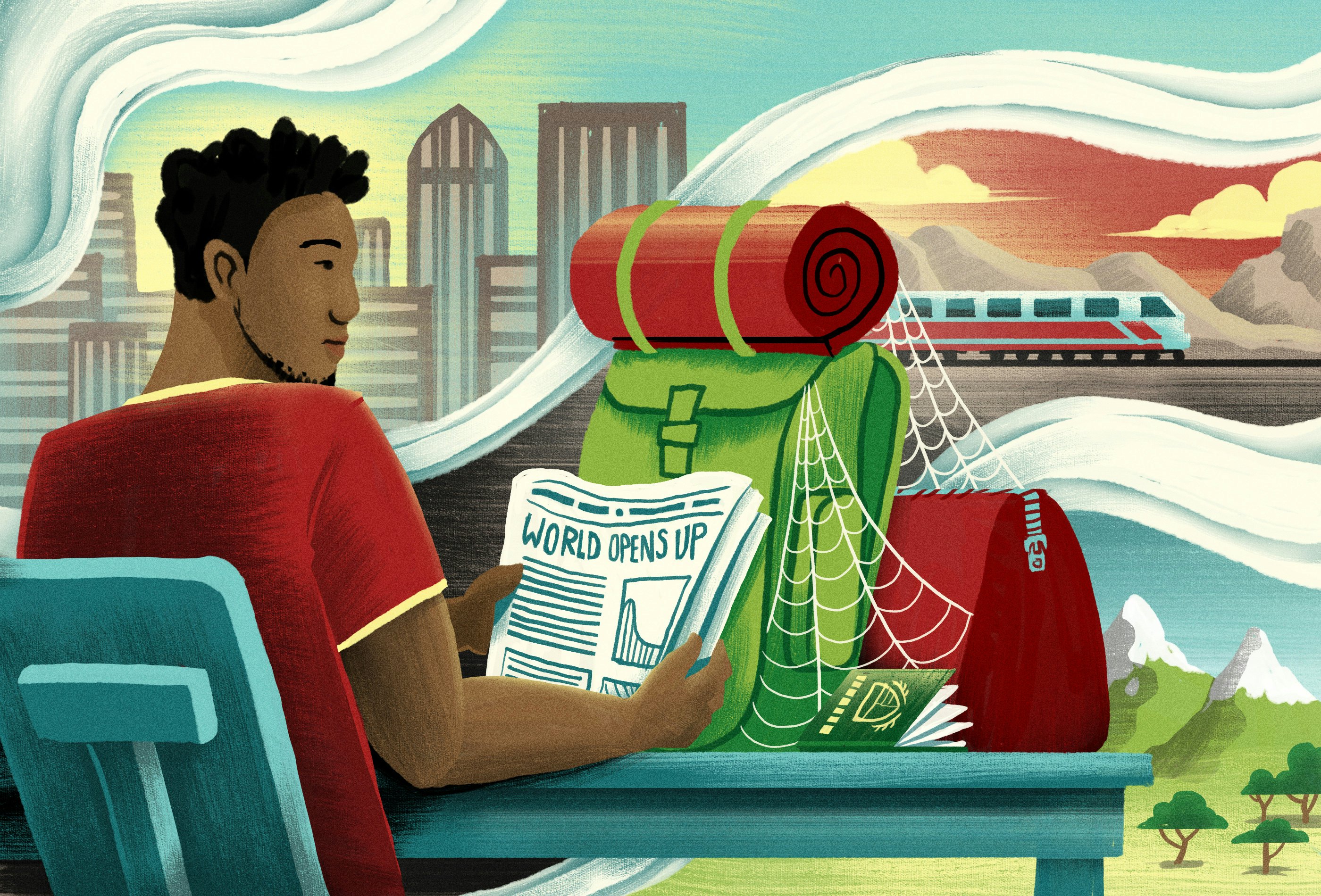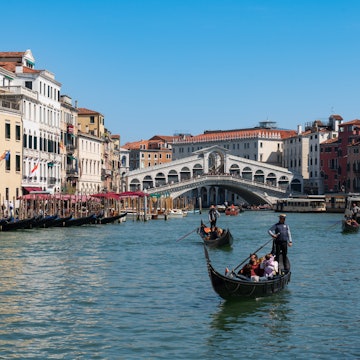

For some, dreams of post-pandemic travel remain distant © Studio MUTI
Kenyan writer Carey Baraka was ready to set off on the first adventure in what he hoped would be decades of wandering. Then, the pandemic hit – and laid bare the challenges of traveling in Africa as an African.
I wonder what versions of ourselves have been lost in this period of being mostly unable to travel. A life ambition of mine has been to stop living anywhere: to stop paying rent, owning furniture, paying for utilities; to remove the normal maintenance work of habitation from my daily life. Instead, I'd be an itinerant traveler, constantly on the road, spending nights in shifty hotels in different countries, becoming a super user on the Couchsurfing app, learning how to say “hello” and "did you catch the game last night" in multiple languages.
As a child, I wanted to be a contestant on the TV show The Amazing Race, hiking through a trail in Brazil or running down a side street in Spain, all in search of clues. In college, a friend and I taught ourselves how to say “I can’t speak this language, but I can speak English” in French, Spanish, and Portuguese, just in case. This was a life I told myself I’d start living after university. In this peripatetic version of myself, I imagined I'd be happier.
I graduated in 2019, but instead of jumping into a life of travel, I underwent a prolonged emotional crisis. Brought down by a series of minor tragedies in my personal life—each almost harmless in itself, but terrible in their sum—I fled Nairobi, where I’d moved for college, retreating to my grandparents’ home in the western part of Kenya. There, my phone mostly off or unavailable, I extracted myself. I ate. I read. I wrote. I read some more. I watched a lot of rom-coms. I listened to a lot of Phil Collins. I attempted to rebalance myself.

A trip imagined
In the midst of all this, my friend Stacy and I were talking, she being one of a few friends I was still in communication with. Stacy and I have known each other since we were kids, but it is only in recent years that we have discovered in each other a shared affinity for travel and a common desire to live a life on the move. We traded dreams until they became itineraries. Eventually, we decided we were going to go on a multi-country road trip from Kenya, into Tanzania, to the city of Kigoma on Lake Tanganyika, and across Zambia to Victoria Falls.
Over several phone calls, we discussed dates, came up with a budget, and plotted a route. We started to save money and I renewed my passport. We decided April 2020 would be our month of travel.
Over those months, I felt the rush that comes from planning a trip. We’d cross the border from Kenya and stop in Arusha, a town in Northern Tanzania that’s considered the safari capital of the world due to its proximity to Mt. Kilimanjaro, Mt. Meru and Serengeti National Park. We didn’t know how long we’d spend there. Spontaneity was the credo.
From Arusha, Kigoma is a thousand kilometers to the west. It’s located on the shores of Lake Tanganyika, near Tanzania’s borders with the Democratic Republic of Congo and Burundi. Our plan was to take seven days to get there, while stopping at the small towns along the way. Maybe we’d stop at Mbulu. Maybe Shinyanga. Maybe Tabora. Maybe another town we didn’t even know about. The goal was to be itinerant drifters, discovering ourselves as we moved through the region. As long as we didn’t go broke, it didn’t matter how long we’d take to get to Kigoma.
We were going to Kigoma because of a ship I’d read about which, though more than a century old, still plies across Lake Tanganyika each week, taking travelers to Zambia. Over three days, the red-hulled ship floats across the second-deepest freshwater lake in the world. I was intrigued as much by the journey as the history.
I knew the basics: The ship, MV Liemba, was part of the German naval fleet during World War I, having been floated for the first time on February 5, 1915, but it was scuttled a year later during the German retreat from Kigoma, and returned to service by the British in 1927. We’d take that very same ship across Lake Tanganyika to its southern tip, disembarking in Mpulungu, Zambia. This was to be the first time I was on a ship. I was excited, curious about sea-sickness, and already nervous about how deep the water was.
We figured it would take about a week to cross the country and reach the Zimbabwean border. Along the way, as we did in Tanzania, we’d discover the pleasures of nameless, faceless towns. Then we’d get to Victoria Falls: “Mosi-oa-Tunya,” or “The smoke that thunders.” We imagined letting the spray wash over our faces, basking in the glory of the waters.
We also imagined we’d be broke two weeks into our trip, so the falls would be our last stop. Instead of crossing the border into Zimbabwe, we’d have to return to Tanzania, which we’d do using the old Tazara railway line—the Chinese-funded 1,860-kilometer railway which, at its completion in 1975, was the longest in Africa—and head to Dar es Salaam. We’d spend a few days in Dar, lying on a beach, the last of our money spent on some cold drinks, speaking Kenyan Swahili to locals, before going back to Kenya.

A trip deferred
I counted down the days until April. This was what I needed to recover: the first multi-country trip for either of us. But then, of course, we never left home. Instead, a pandemic swept across the globe. In March, Kenya announced its first case and borders were closed. The government announced a raft of restrictions and a curfew that was still in place more than a year later. Here we still are, all this time later, trapped.
A few months into the pandemic, dreams of my journey with Stacy starting to fade, I met a photographer friend in his Ethiopian restaurant in Nairobi. It was almost dusk, just a few minutes until the curfew set in, and the mosquitoes had started their evening buzzing. We were talking about travel, and I told him about the time I visited Lake Turkana, also known as the Jade Sea, in Northern Kenya. Turkana, the largest desert lake in the world, crosses the border with Ethiopia. I described how beautiful the water was, how it taught me what the color jade really meant.
He told me about a road trip he had taken with his friends. They were passing through Mozambique on their way to South Africa when everything went wrong. They found themselves in an unfamiliar place, hearing an unfamiliar language, nervous about their safety, waiting for a bus that might never come. I was fascinated and hung on to every new twist in the story. I quickly realized the word for what I was feeling was envy.
Envy is not an uncommon feeling for us future travelers. Sometimes it’s money we envy, the ability to jet off to another part of the world without having to scrimp and save for months. Sometimes, it’s passports we envy, and wonder at the true spontaneity that can come from visa-on-arrival status.
A trip just a vaccine away
Travel has always been unequal. Before the pandemic, we could rely on, among other things, visa politics and racism to hold certain hegemonies in place. Now, however, in the wake of such prolonged stillness, Covid-19 has prompted new questions about these inequalities and what responsible travel looks like.
One of the manifestations of this inequality is the fact that people from several Western countries have, throughout the course of the pandemic, been going on vacations in the Global South while the reverse is much more difficult to do. Fleeing a ban on partying in their native Germany, an enclave of DJs threw weekly parties in Tanzania’s premier coastal tourist spots, with Zanzibar a particularly popular destination for Western travelers seeking to escape Covid restrictions in their countries. Further north, the Kenyan island town of Lamu, a UNESCO World Heritage site, has been transformed into Notting Hill as wealthy Britons seek to rediscover themselves in Africa. Here, you can be, as one article gloated, “maskless and topless” and live your best life.
There are conversations being had in several Western countries about Covid passports. The logic is sound: after all, one does need certain vaccines in order to travel to some countries. However, Covid vaccines are barely available in the Global South. While, for instance, the United States has vaccinated more than half of its citizens, only 2.4% of people living in Africa have been vaccinated. If a Covid passport is a requirement for travel, then movement becomes a two-tier system with the Global North up top while the rest of us, unfortunately, occupy the lower rung.
On Twitter, I’ve been seeing people joyous at the prospect of summer and all the partying they’ll do to make up for the past year. The Euros have just finished and there were thousands of supporters in the stands, the beneficiaries of vaccine programs. None of this is my reality. Instead, I’ve spent the past week in an even more intense isolation than before. A few days ago, Stacy texted about a new trip we had been planning, a trip within Kenya this time. I told her that I was sick and wasn’t able to travel yet. I didn’t tell her that it was Covid.
You may also like:
A new electric safari car will aid conservation efforts in Kenya
Kenya's 10 best natural wonders
Finding sanctuary in one of America’s only Native-owned breweries













